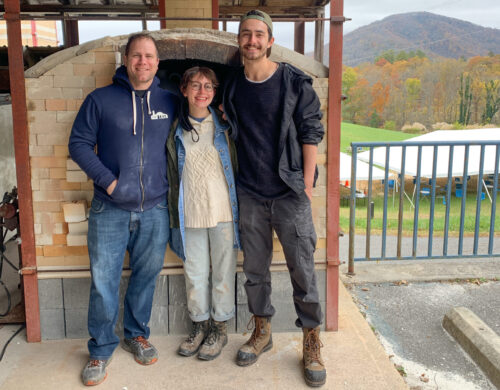How has craft been represented through a variety of media? What impact does representation through the particularities of images, films, spoken and written words, digital platforms have on how craft is practiced and understood? To what extent do representations focus upon materials, tools, practices, makers, environments? How has the dialogue between craft and representation informed the transmission of craft skills? How has the mediation of craft informed its status within debates about heritage and identity? In what ways might translation across particular modalities of communication resonate distinctly locally, transnationally, globally? How has the representation of craft been mobilised to generate or to problematise consumption?
This series features speakers worldwide and across the widest possible range of disciplines and career stages who are thinking critically about intersections between craft and representation. 10-minute presentations in English illustrated by a single PowerPoint slide will generate a dialogue amongst all participants. These dialogues will be ‘live’ via Zoom on alternate Thursdays at 19.30 hrs GMT from 20 January – 31 March 2022. Please visit our listings page for the full programme here.
This week’s session is themed CRAFTING LABOUR
Access event via ZOOM: https://us02web.zoom.us/j/87686329779
Jesse Adams Stein – Rethinking representations of industrial craft: Beyond the nostalgic “lost craftsman.”
While recent years have seen a flourishing of intellectual energy directed towards a wide range of craft practices, industrial craft – that is, craft skill undertaken as paid labour in industrial and manufacturing settings – has received less attention. The familiar image of the “lost craftsman” remains a lingering and problematic historical trope. In this rendering, the skilled industrial craftsperson is often cast as a tragic and redundant figure, mere collateral damage amid supposedly inevitable economic, technological and political forces associated with deindustrialisation. While this representation captures some of the profound disruption that was inflicted upon industrial craft labour throughout the second half of the twentieth century, it does not fully account for the gendered, class-based and material complexity of industrial craftspeople’s everyday experiences of economic restructuring, of digitisation and of the neoliberalisation of global labour. Furthermore, it does not capture the ongoing nature of some aspects of industrial craft practice. There is a great deal more to explore, in terms of uncovering and reassessing the buried connections between design culture and industrial production, particularly at the level of everyday human experience.
In this presentation (and in their research more broadly) Adams Stein attempts to avoid these ‘rose-tinted’ representations. Instead, they engage closely with the lives of skilled manufacturing workers (men and women) in Australia, from industries such as steelmaking, automotive design and manufacturing, plastics production and industrial model-making. Drawing from oral histories and ethnographic fieldwork, Adams Stein focuses on detailed life stories and attends to the material specificity of industrial craft practice, from the shop floor to the home-workshop. This has enabled understandings about the ways in which apprenticeship, gendered-work relations, family structure, retraining and technologies have each shaped the skills, identities and creative practices of industrial craftspeople.
Dr Jesse Adams Stein is a Senior Lecturer and Australian Research Council DECRA Fellow at the UTS School of Design, Sydney. Stein is a design researcher and oral historian whose work shifts between historical and contemporary contexts and focuses on the quieter and less fashionable sides of design: industrial craft, manufacturing, repair, skill loss and labour relations in the face of economic and technological change. She is the author of Industrial Craft in Australia (Palgrave Macmillan 2022), and Hot Metal: Material Culture & Tangible Labour (Manchester UP 2016).
Anita Puig – ‘Inherited stitches. Journal of an anonymous seamstress.’
This abstract examines from a historical and heritage perspective, the unwritten language of sewing: a representation, a feminine practice, and as an instructive tool to massively educate women in Chile. Through this abstract, universal language, illiterate women and girls who attended technical schools, could discuss and interchange techniques, experiences, transforming it into a tool for economical independence, a mean to organize women outside their houses and helped them to gain a voice to support women rights through a trade union newspaper led by Esther Valdés de Díaz the founder of the Asociación de Costureras (Seamstresses Association) where they posted samples from their work.
Traces, kept in journals and notebooks portray not only a long term tradition of women, crafts and treatises, but also refer to a complete period of time in the Education of Women, the opening of the first Technical Schools in Chile. These schools promoted by the state can be found since 1888 in Santiago and lasted until the 1970´s when schools shifted to new educational methods. Within this educational method, household economy was organized, and fostered the approach for women to join the workforce and industrialization. The study of these fragments, that belonged to an anonymous woman, reveal traces of her life and a deep interest in protecting a language that will be inherited by their daughters or peers. The visual representation exceeds the written language, and the dissonance between a poor written text and a well executed sample or stitch is evident in this journal. The technique, the executer and the representation become one voice in this period of time, and defined a mode of making, learning and activism.
Anita Puig Gómez was born in Santiago, Chile and is an Architect, currently finishing their Phd in Architecture and Urban Studies at Pontificia Universidad Catolica de Chile. Puig’s interest topic, as well as their dissertation, has focused on History and Architectural Theory, with particular interest on Modern Architecture, interiors and women studies. Puig has also developed research regarding the cultural and spatial connections between interiors, clothes and architecture.
Courtney Schum – ‘A Trading Space: Realist Images of the Worker in Carved Timber Reliefs at Copenhagen’s Workers’ Assembly Hall, 1934-35.’
This presentation will discuss a set of 14 timber relief panels featuring Danish crafts- and tradespeople in the former Worker’s Assembly Hall on Rømersgade 22, now a preserved museum object at the centre of Copenhagen’s Arbejdermuseet (Worker’s Museum). This space was the first of its kind in the city, purpose built to offer a shared meeting and social space for Copenhagen’s trade unions. Opened in 1879, it features parquet floors, marble, and gilding, generally emulating sumptuous bourgeois aesthetics. However, the installation of these reliefs marks a critical shift towards the incorporation of realist representations of the Danish worker to Copenhagen’s built environment.
The reliefs were installed between 1934 and 1935 by unemployed members of the Carvers’ Union. Each panel displays 1-2 individuals with the tools and products of their craft, in the act of working. They are carpenters, shoemakers, tobacco workers, metal smiths, bakers, servers, masons, plumbers, typographers, bookbinders, tailors, and textile workers—time-resistant professions involving physical labour, heavy machinery, and high technical ability. Their clothes are accurate to the time and work shown. The reliefs’ rough, unpainted surfaces bare evidence of the carving tools, the timber’s materiality, and maker’s hand.
The reliefs sit in juxtaposition to the hall’s refined ceramic ceiling tiles from 1907, which feature only female figures awash in an Italianate and Jugendstil pastiche. Dressed in anachronistic historical costume, they are intended to represent painting, upholstery, and smithery. They hold symbols of the product of trade, but neither their clothing nor their physicality evidence any labour. These tiles show a romanticised concept of work. The carved reliefs, by contrast, show the worker, and therefore are critical artefacts in the history of workers’ visual culture in 20th-century Denmark, which increasingly rejected bourgeois aesthetics in favour of realist self-representation and exultation of trade, industry, and craft.
Courtney Schum is in her 3rd year of a PhD in History of Art at University of Bristol under the supervision of Professor Mike O’Mahony. Schum is interested in 20th-century European design and architecture, theories of place and urbanism, and the material culture of welfare systems. Using architecture, public art, graphic design, sculpture, printed material, and film, her thesis, A Meeting Place for All: The Folkets Hus and Visual Culture of Danish Social Democracy assesses expressions of Danish social democratic attitudes emerging from the workers’ assembly buildings of Copenhagen.












